ISSN ONLINE(2319-8753)PRINT(2347-6710)
ISSN ONLINE(2319-8753)PRINT(2347-6710)
Dipak G. Vamja1, G. G. Tejani2
|
| Related article at Pubmed, Scholar Google |
Visit for more related articles at International Journal of Innovative Research in Science, Engineering and Technology
Automotive industry is on the verge of development and more comforts are being incorporated in a vehicle. On other hand customers have stringent demand of fuel economy, high performance at low cost. In order to have high fuel economy the auto-motive manufacturers are induced to reduce weight. Author has selected composite material of Aluminium composite material (Aluminium skin, polyethylene core, resin binder material). Tensile strength, bending strength has been carried out on Universal Testing Machine (UTM) to optimize of mass of composite material. One can use sandwich panel composite material to optimize mass and cost of various automobile, marine, aerospace and various structures.
Keywords |
| Composite material, Aluminium plate, Polyethylene plate, binder material, Hexagonal structure, sandwich panel composite, Universal Testing Machine (UTM). |
INTRODUCTION |
1.1 Introduction of composite material |
| The word composite in the term composite material signifies that two or more materials are combined on a macroscopic scale to form a useful third material. The advantage of composite materials is that, if well designed, they usually exhibit the best qualities of their components or constituents and often some qualities that neither constituent possesses [9]. |
1.2 sandwich panel |
| Sandwich structured composites are a special class of composite materials which have become very popular due to high specific strength and bending stiffness. Low density of these materials makes them especially suitable for use in aeronautical, space and marine applications. Geometry of sandwich plate is shown in figure 1.1. |
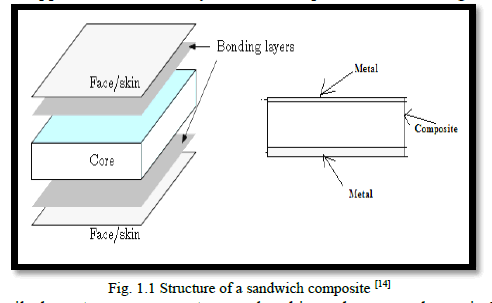 |
| Sandwich composites primarily have two components namely, skin and core as shown in Figure 1.1. If an adhesive is used to bind skins with the core, the adhesive layer can also be considered as an additional component in the structure. The thickness of the adhesive layer is generally neglected because it is much smaller than the thickness of skins or the core. The properties of sandwich composites depend upon properties of the core and skins, their relative thickness and the bonding characteristics between them [5]. |
II. HONEYCOMB CORE SANDWICH PANEL |
2.1 Introduction of honeycomb core |
| For design and construction of lightweight transportation systems such as satellites, aircraft, high-speed trains and fast ferries, structural weight saving is one of the major considerations. To meet this requirement, sandwich construction is frequently used instead of increasing material thickness. This type of construction consists of thin two facing layers separated by a core material. Potential materials for sandwich facings are aluminium alloys, high tensile steels, titanium and composites depending on the specific mission requirement. [1]. |
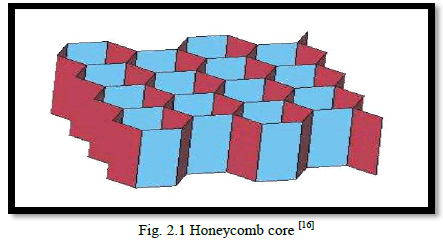 |
2.2 Definition of the unit cell |
| This unit cell is a hexagonal cell. In fact, with a hexagonal cell, it is possible to describe the entire honeycomb core. The periodicity of the structure is used here. In the second time, the unit cell is built up with one quarter of one central wall and one quarter of one inclined wall. This reduction in the size of the cell to be studied is because of the different symmetries [8]. |
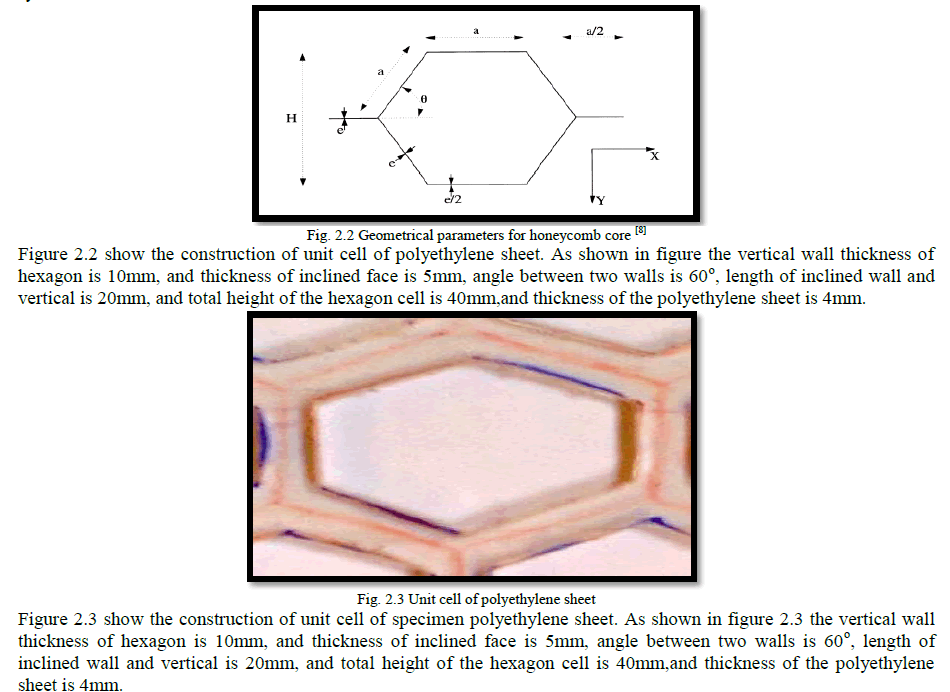 |
III. MATERIAL SELECTION FOR SANDWICH PANEL |
3.1 Aluminium composite Panel |
| Aluminium is a very versatile metal, touches every aspect of our lives, from aircrafts to Automobiles, from power cables to foils, aluminium can be fashioned into myriad shapes in a variety of applications and lately the building industry has caught the fancy of the versatility and Performance of the material. |
Methods
|
3.3 Binder materials and its property |
| The choice of a resin system for use in any component depends on a number of its characteristics, with the following probably being the most important for most com- posited structures [9]. Resin use in sandwich panel is Epoxy resins because two important mechanical properties of resin system are tensile strength and stiffness. Epoxy based laminates tend to show very good fatigue resistance when compared with both polyester and vinyl ester, this being one of the main reasons for their use in aircraft structures. |
IV. EXPERIMENTAL SET-UP FOR TENSILE TEST AND RESULT |
4.1 Tensile test of composite material |
| Two type of shape consider for tensile test, without hexagonal construction of inner core material simple or solid polyethylene sheet or plate is used, and with hexagonal construction hexagonal shape of polyethylene composite plate were used. |
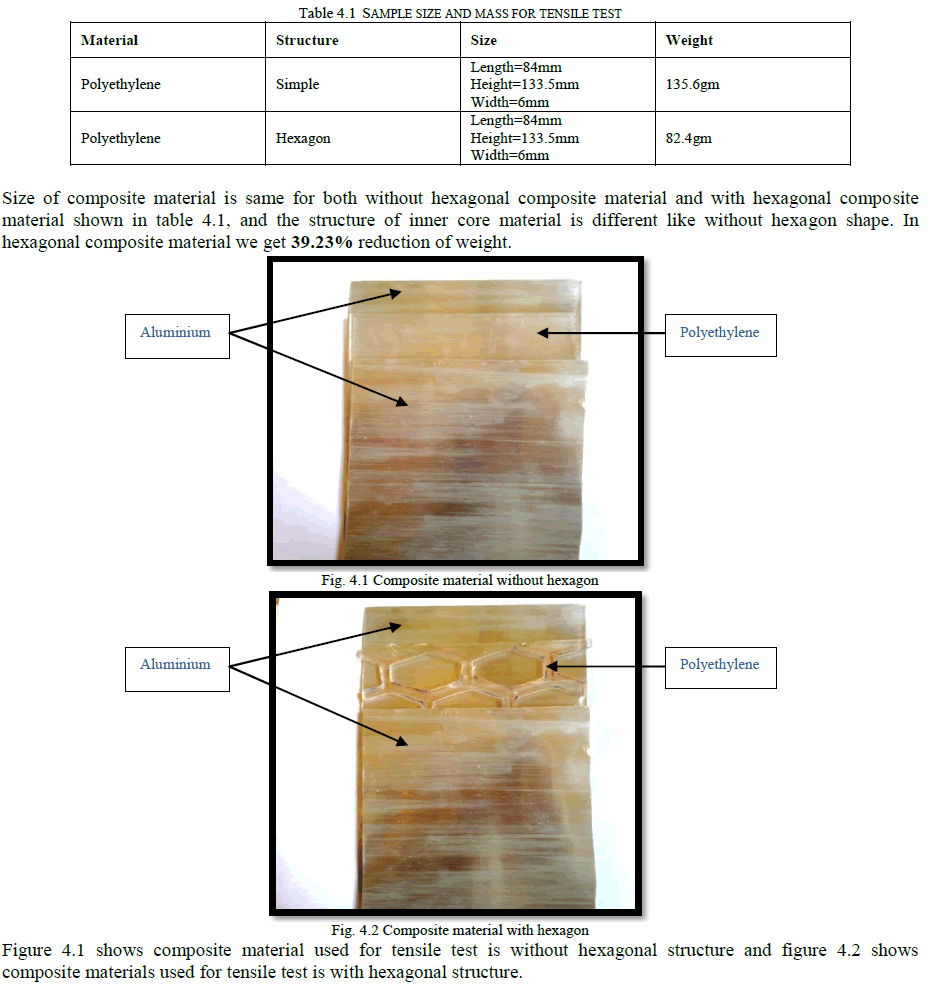 |
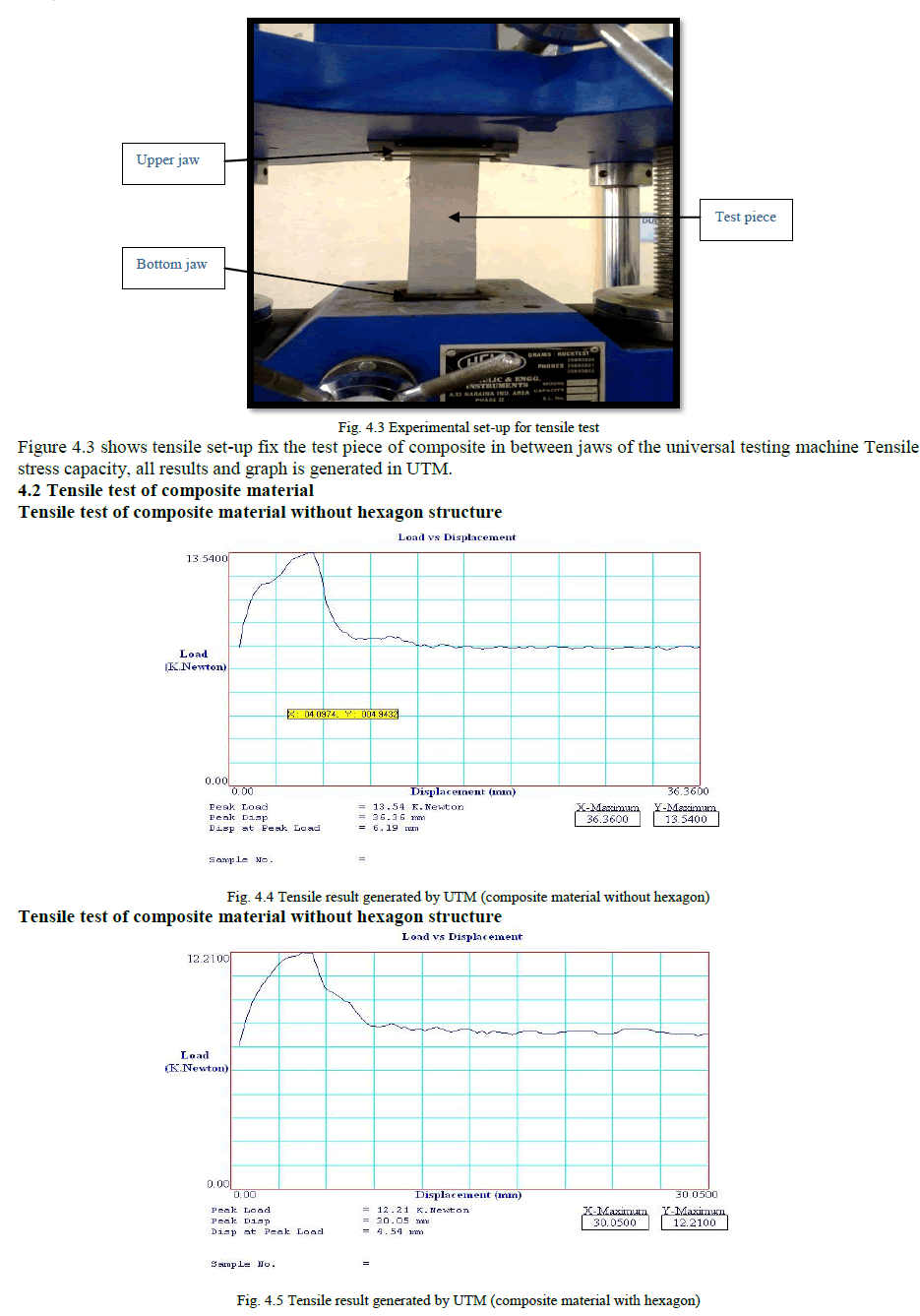 |
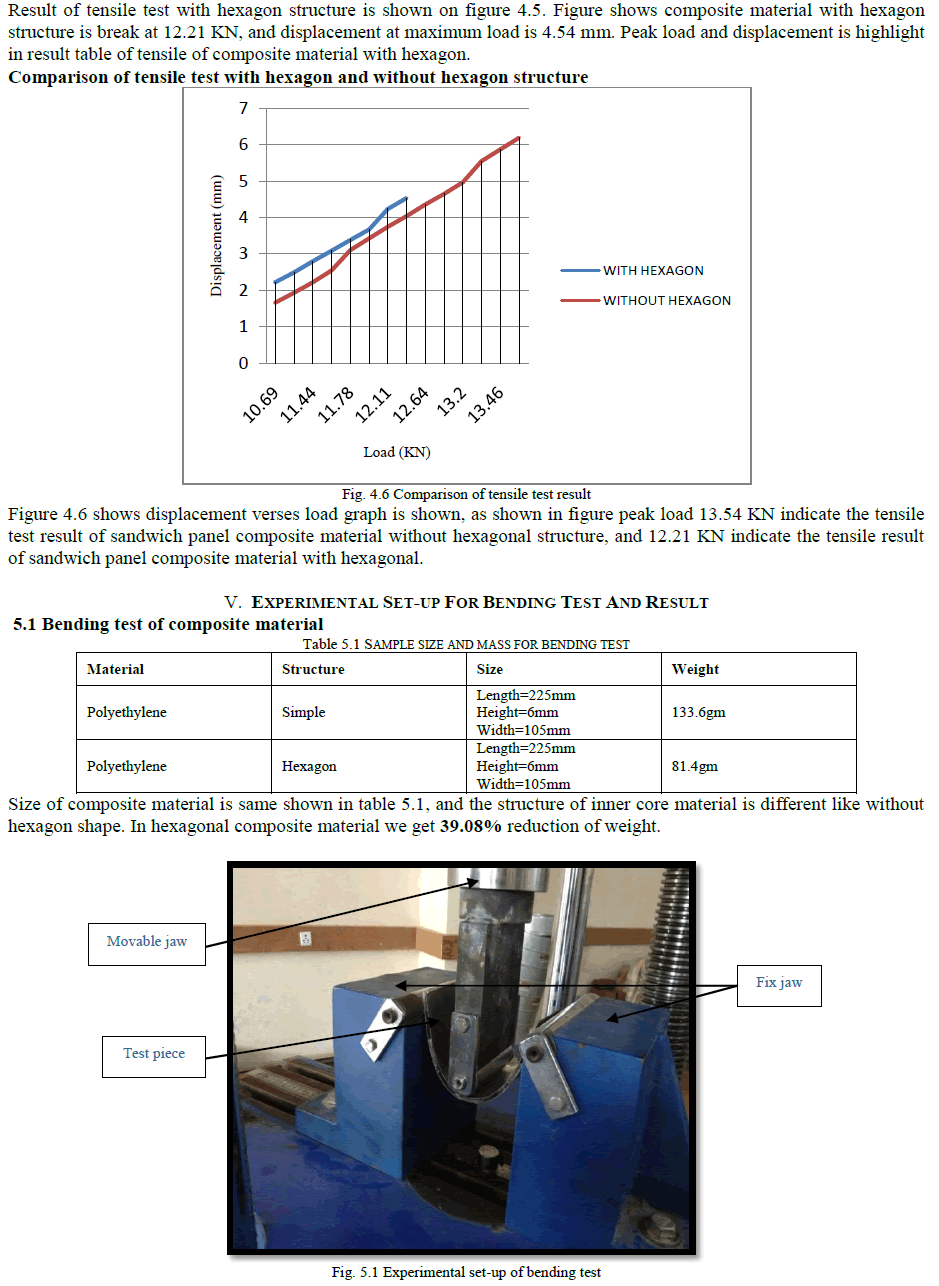 |
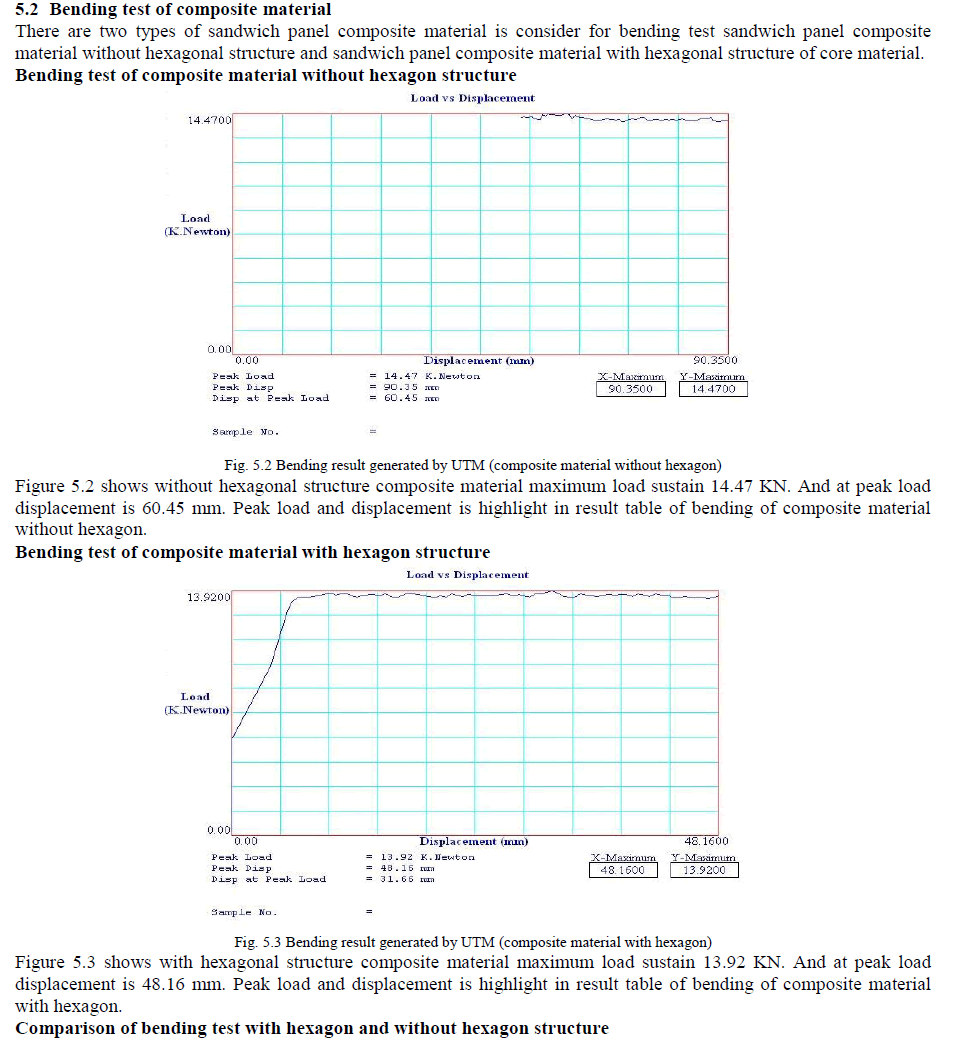 |
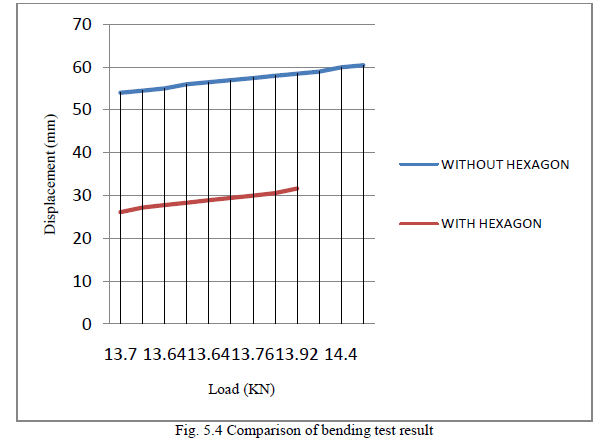 |
| Figure 5.4 shows displacement verses load graph is shown, as shown in figure 14.47 KN indicate the bending test result of sandwich panel composite material without hexagonal structure, and 13.92 KN indicate the bending result of sandwich panel composite material with hexagonal. |
VI. CONCLUSION |
| Bending test, tensile test is performed on sandwich panel composite material. Two type of inner core structure is considered for sandwich panel composite material, without hexagonal composite material, and with hexagonal composite material. And it is observed that with hexagonal composite material weight saving is 39% compared with without hexagonal composite material. From tensile test and bending test of composite material, tensile strength and bending strength capacity of with hexagonal composite material is less compare to without hexagonal composite material, but it can be negligible. Hence sandwich panel composite material (with hexagonal structure) is acceptable in Automobile, Aerospace, and Marine engineering. |
References |
|